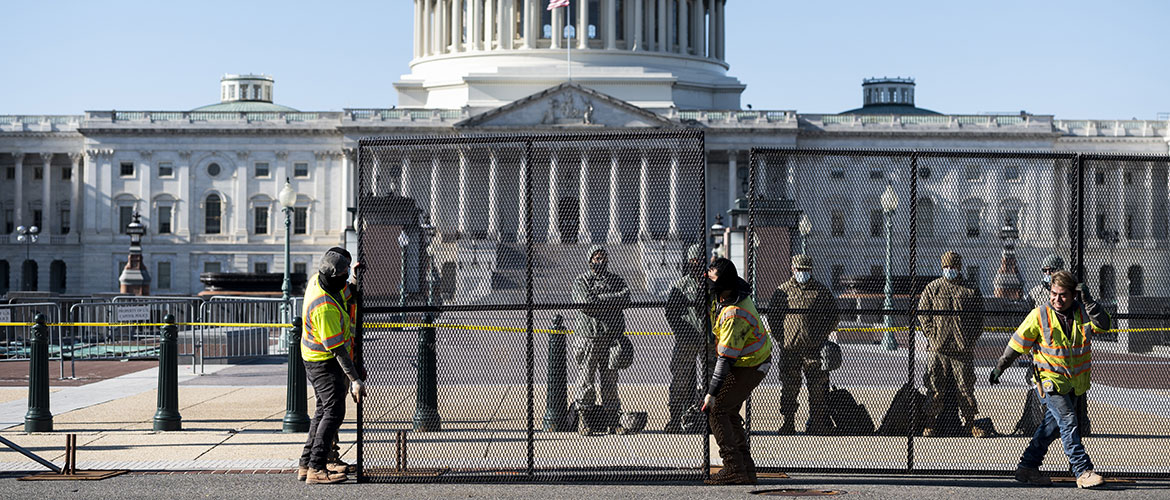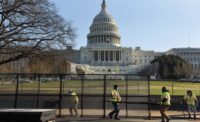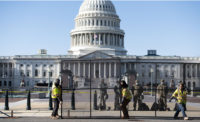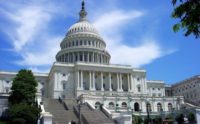After the previous day’s unprecedented riots, workers beefed up temporary fencing around the U.S. Capitol Complex Jan. 7. Federal officials say the fence will remain in place for 30 days. The bedlam that left five people dead—including a Capitol police officer—after supporters of President Donald Trump stormed the Capitol Building also prompted some pundits and security experts to call for a permanent barricade around the nation’s most visible symbol of democracy.
Permanent security measures installed on and around the Capitol, to date, are mostly designed to balance safety and accessibility for the compound’s various buildings and grounds. “It’s a beacon for the United States, it represents all of our ideals, but at the same time we’re trying to make sure they can continue their function,” says Peggy Van Eepoel, senior principal and a security specialist at Thornton Tomasetti, and its Washington,, D.C. director.
Broadly speaking, Van Eepoel—who has worked on several projects within the Capitol compound—says striking the balance between openness and security is one of her team’s biggest challenges when working on the National Mall. “It struck us just how much this demonstrated that," she said. Van Eepoel could not speak to specific current security measures at the Capitol because of nondisclosure agreements.
On the other hand, Terry Gainer, former chief of the Capitol Police and former Senate sergeant-at-arms, told National Public Radio that, in “retrospect,” a fence should have been erected earlier. He added, “We’ve made suggestions from a security point of view that have been rejected.”
Others continue to advocate to maintain more passive measures. “The fence will take care of it, but the fence is not an appropriate intervention,” a former government employee with knowledge of Capitol security told ENR as the riot unfolded. “The police have to find other ways, whether it’s increased manpower or portable measures. I’m not quite sure what the solution is, but I know what the solution isn’t.”
The former official called the breach a “real security failure” but said it wasn’t a “physical infrastructure failure” because “the police perhaps didn’t have the right manpower or weren’t in the right place.”
Thomas Vonier, a Washington, D.C., and Paris-based-architect with experience in building security, agrees. The president of the International Union of Architects and past president of the American Institute of Architects says security measures for government facilities in the U.S. don’t typically, " address mob riot scenarios; they aim at deterring vehicle-borne explosives, vehicle ramming attacks, and small-arms attacks by individuals or small paramilitary units. ... The U.S. Capitol is a symbol of our democratic republic. We can’t outfit it as a fortress or an armed camp."
The experts agree that all facets of security at the Capitol will be examined and updated, creating lessons learned that will stretch far beyond the Capitol. Van Eepoel says her firm has fielded an increased number queries from clients—federal and otherwise—concerned about civil unrest.
“It will be an event that will be a reference that we can learn a lot of lessons from,” she says.
Between A Rock and a Hard Place
Security at the Capitol Complex has been upgraded over the years after several incidents. In 1998. a gunman killed two Capitol Hill police officers.
One of the Capitol’s most significant security upgrades, the $600-million Capitol Visitor Center, opened in 2008. It was designed and constructed so that almost everyone who enters the Capitol complex does so from a security checkpoint about a football field away from the building itself.
Designed and constructed security upgrades at the Capitol Complex, including the Visitor Center, fall under the purview of the Architect of the Capitol (AOC). A spokeswoman for the current AOC, J. Brett Blanton, did not respond to a request for comment. As AOC, Blanton’s duties include serving on the Capitol Police Board.
The Visitor Center’s designer RTKL, now CallisonRTKL, declined to comment, as did the project’s contractor, Manhattan Construction.
While the Capitol Visitor Center is the complex’s “front door,” the former government official interviewed for this story said there are other doors used by members of Congress that remain open out of convenience. “At some point those other doors should be locked down or those doors should have security measures put in place that are similar to those in the Capitol Visitor Center.”
Rioters on Jan. 6 tore through flimsy temporary fencing on the grounds as hundreds of people rushed the building. The mob gathered on the Capitol steps before some of its members broke a window and entered the building. Others rushed through the main doors to the side of the building that houses the House chamber.
Once inside, the mob seemed to freely roam throughout the building without much resistance, forcing a lockdown that disrupted Congress’ certification of President-Elect Joe Biden’s Electoral College victory.
Officer Killed Defending Capitol
Capitol police officer Brian D. Sicknick died on Jan. 7, according to a press release from the U.S. Capitol Police. The officer was "injured while physically engaging with protesters" and then "returned to his division office and collapsed. He was taken to a local hospital where he succumbed to his injuries," the release says. Media reports indicate there were around 60 other officers injured, with several still hospitalized.
One rioter was shot and killed during a standoff inside the building between law enforcement and protesters. Three others suffered “medical emergencies” during the riot and subsequently died.
While hardening breached doors and windows seems like an easy starting point to bolster security at the Capitol, Van Eepoel says it’s not so simple to design functioning windows that also protect against a blast load, forcible entry and ballistics all at once, especially on a 228-year-old historic building with “architectural limitations.” She says you have to “take all those things together and try to figure out a solution. There are windows designed for all those things, but they might not do everything else well.”
Preventing intruders who do breach doors and windows from circulating throughout the building is also a challenging balance. “If you establish the baseline that people can’t get [into the building], then maybe you don’t compartmentalize the building as much,” Van Eepoel says.
She says many schools concerned about active shooters have developed ways to maintain day-to-day circulation with the ability to compartmentalize the building in the event of an emergency. Taking such measures at the Capitol could include door locks, reconstructing doors and building partitions. “I’m sure there’s going to be a full evaluation of that,” Van Eepoel says.
Passive Resistance
After the 2012 shooting in Newtown, Conn., killed 20 first-graders and six adults, designers aimed to fortify the new Sandy Hook Elementary School without re-traumatizing survivors. The project team installed footbridges over a rain garden constructed directly in front of the building. They also used bioswales to create a natural buffer to the building.
Van Eepoel says natural security measures such as these wouldn’t work in the same way at the Capitol, but it is helpful to consider such remedies when thinking about security more creatively. “There is certain landscaping that is not very friendly to people trying go through it,” she says.
Creating differences in elevations with retaining walls that are difficult to climb but blend into the landscape is another possible solution, she says.
Her team at Thornton Tomasetti recently increased security at the Washington Monument New Visitor Facility without obstructing the monument by building a “ha-ha wall”—as in “we fooled you”—to keep cars at bay. She says the wall has a “tiered plateaued retaining wall that goes around the site. If you’re standing on the street, you don’t perceive it as a wall. You perceive it as a sloped expanse of grass because of the way it’s landscaped.”
Designers could also consider U.S. embassies designed to stop rioters from penetrating perimeters while also maintaining a democratic ideal, Van Eepoel says. She notes that the security design has come a long way since “kneejerk reactions” after the Sept. 11, 2001, terrorists’ attacks resulted in planters and temporary measures, some of which are still in place today.
“With time, thought, creativity and collaboration, we can come up with a solution that isn’t just, ‘Let’s put a wall around this building,’” she says, adding that those solutions can much more embody “the United States” and what “our representation is to the world and to our country.”






Post a comment to this article
Report Abusive Comment